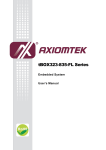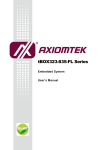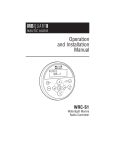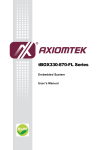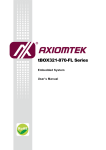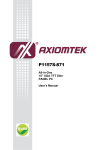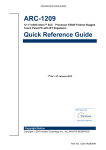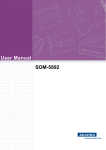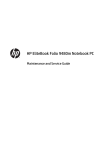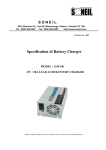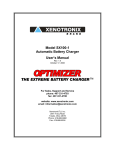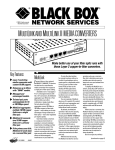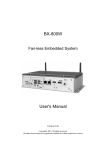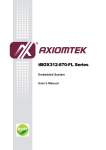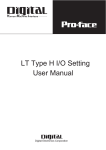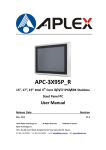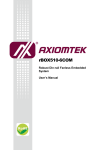Download User`s Manual
Transcript
tBOX322-882-FL Series Embedded System User’s Manual Disclaimers This manual has been carefully checked and believed to contain accurate information. Axiomtek Co., Ltd. assumes no responsibility for any infringements of patents or any third party’s rights, and any liability arising from such use. Axiomtek does not warrant or assume any legal liability or responsibility for the accuracy, completeness or usefulness of any information in this document. Axiomtek does not make any commitment to update the information in this manual. Axiomtek reserves the right to change or revise this document and/or product at any time without notice. No part of this document may be reproduced, stored in a retrieval system, or transmitted, in any form or by any means, electronic, mechanical, photocopying, recording, or otherwise, without the prior written permission of Axiomtek Co., Ltd. Copyright 2014 Axiomtek Co., Ltd. All Rights Reserved Oct 2014, Version A1 Printed in Taiwan ii Safety Precautions Before getting started, please read the following important safety precautions. 1. User should not modify any unmentioned jumper setting without Axiomtek FAE’s instruction. Any modification without instruction might cause system to become damage 2. The tBOX322-882-FL does not come equipped with an operating system. An operating system must be loaded first before installing any software into the computer. 3. Be sure to ground yourself to prevent static charge when installing the internal components. Use a grounding wrist strap and place all electronic components in any static-shielded devices. Most electronic components are sensitive to static electrical charge. 4. Disconnect the power cord from the tBOX322-882-FL before making any installation. Be sure both the system and the external devices are turned OFF. Sudden surge of power could ruin sensitive components. Make sure the tBOX322-882-FL is properly grounded. 5. Make sure the voltage of the power source is correct before connecting the equipment to the power outlet. 6. Turn OFF the system power before cleaning. Clean the system using a cloth only. Do not spray any liquid cleaner directly onto the screen. 7. Do not leave this equipment in an uncontrolled environment where the storage temperature is below -40℃ or above 80℃. It may damage the equipment. 8. Do not open the system’s back cover. If opening the cover for maintenance is a must, only a trained technician is allowed to do so. Integrated circuits on computer boards are sensitive to static electricity. To avoid damaging chips from electrostatic discharge, observe the following precautions: Before handling a board or integrated circuit, touch an unpainted portion of the system unit chassis for a few seconds. This will help to discharge any static electricity on your body. When handling boards and components, wear a wrist-grounding strap, available from most electronic component stores. iii Classification 1. 2. 3. 4. Degree of production against electric shock: not classified Degree of protection against the ingress of water: IP40 Equipment not suitable for use in the presence of a flammable anesthetic mixture with air or with oxygen or nitrous oxide. Mode of operation: Continuous General Cleaning Tips You may need the following precautions before you begin to clean the computer. When you clean any single part or component for the computer, please read and understand the details below fully. When you need to clean the device, please rub it with a piece of dry cloth. 1. Be cautious of the tiny removable components when you use a vacuum cleaner to absorb the dirt on the floor. 2. Turn the system off before you start to clean up the component or computer. 3. Never drop the components inside the computer or get circuit board damp or wet. 4. Be cautious of all kinds of cleaning solvents or chemicals when you use it for the sake of cleaning. Some individuals may be allergic to the ingredients. 5. Try not to put any food, drink or cigarette around the computer. iv Cleaning Tools: Although many companies have created products to help improve the process of cleaning your computer and peripherals users can also use household items to clean their computers and peripherals. Below is a listing of items you may need or want to use while cleaning your computer or computer peripherals. Keep in mind that some components in your computer may only be able to be cleaned using a product designed for cleaning that component, if this is the case it will be mentioned in the cleaning. Cloth: A piece of cloth is the best tool to use when rubbing up a component. Although paper towels or tissues can be used on most hardware as well, we still recommend you to rub it with a piece of cloth. Water or rubbing alcohol: You may moisten a piece of cloth a bit with some water or rubbing alcohol and rub it on the computer. Unknown solvents may be harmful to the plastics parts. Vacuum cleaner: Absorb the dust, dirt, hair, cigarette particles, and other particles out of a computer can be one of the best methods of cleaning a computer. Over time these items can restrict the airflow in a computer and cause circuitry to corrode. Cotton swabs: Cotton swaps moistened with rubbing alcohol or water are excellent tools for wiping hard to reach areas in your keyboard, mouse, and other locations. Foam swabs: Whenever possible it is better to use lint free swabs such as foam swabs. NOTE: We strongly recommended that you should shut down the system before you start to clean any single components. Please follow the steps below: 1. Close all application programs 2. Close operating software 3. Turn off power switch 4. Remove all device 5. Pull out power cable v Scrap Computer Recycling If the computer equipments need the maintenance or are beyond repair, we strongly recommended that you should inform your Axiomtek distributor as soon as possible for the suitable solution. For the computers that are no longer useful or no longer working well, please contact your Axiomtek distributor for recycling and we will make the proper arrangement. Trademarks Acknowledgments Axiomtek is a trademark of Axiomtek Co., Ltd. Windows® is a trademark of Microsoft Corporation. AMI® is a registered trademark of American Megatrends Inc. IBM, PC/AT, PS/2, VGA are trademarks of International Business Machines Corporation. Intel® and Atom™ are trademarks of Intel Corporation. Winbond is a trademark of Winbond Electronics Corp. Other brand names and trademarks are the properties and registered brands of their respective owners. vi Table of Contents Disclaimers ............................................................................................................... ii Safety Precautions .................................................................................................. iii Classification ........................................................................................................... iv CHAPTER 1 INTRODUCTION .............................................................................1 1.1 General Description ........................................................................................ 1 1.2 System Specifications .................................................................................... 2 1.2.1 CPU ................................................................................................................... 2 1.2.2 System I/O ........................................................................................................ 2 1.2.3 System Specification....................................................................................... 2 1.2.4 Driver CD Content ............................................................................................ 3 1.3 Dimensions ..................................................................................................... 4 1.4 I/O Outlets ........................................................................................................ 5 1.5 Packing List ..................................................................................................... 6 CHAPTER 2 HARDWARE INSTALLATION .....................................................7 2.1 Installing the swappable HDD/SSD or CFast Card ...................................... 7 2.2 Installing the Express Mini Card and SIM card ............................................ 8 2.3 Installing the HDMI bracket ............................................................................ 9 CHAPTER 3 Jumper Setting & Connector .........................................................10 3.1 mSATA/CFast Setting ...................................................................................... 10 3.2 Connectors .................................................................................................... 11 3.2.1 DVI-I Connector .............................................................................................. 11 3.2.2 Serial Port Connector .................................................................................... 12 3.2.3 USB3.0 Stack Ports ....................................................................................... 12 3.2.4 LED Indicators ............................................................................................... 13 3.2.5 DC Power Input connector............................................................................ 13 3.3.6 M12 LAN Connector (LAN1,2)....................................................................... 13 3.2.7 Digital I/O Connector ..................................................................................... 14 3.2.8 M12 USB 2.0 Connector ................................................................................ 14 3.2.9 M12 Audio Connector .................................................................................... 14 3.2.10 PCI-Express Mini Card Connector ................................................... 15 3.2.11 CFast™ Socket................................................................................... 16 3.2.12 Remote switch Connector ................................................................ 17 3.2.13 HDD tray locker .................................................................................. 17 CHAPTER 4 AMI BIOS Setup Utility ................................................................19 4.1 Starting .......................................................................................................... 19 4.2 Navigation Keys ............................................................................................ 19 4.3 Main Menu ..................................................................................................... 21 4.4 Advanced Menu ............................................................................................ 22 4.8 Save & Exit Menu .......................................................................................... 32 APPENDIX A WATCHDOG TIMER..................................................................33 APPENDIX B DIGITAL I/O .................................................................................35 vii This page is intentionally left blank. viii tBOX322-882-FL Series User’s Manual CHAPTER 1 INTRODUCTION This chapter contains general information and detailed specifications of the tBOX322-882-FL. The Chapter 1 includes the following sections: 1.1 General Description System Specification Dimensions I/O Outlets Package List General Description The tBOX322-882-FL is an embedded system that supports onboard 4th Gen. Intel® Core™ i3 or 4th Gen. Intel® Core™ i7 processor, to provide Windows® 7, Windows® 8, Windows® Embedded and Linux, suitable for the most endurable operation. It features fanless design with full feature I/O, supports onboard 4GB/8GB DDR3L memory, and enhanced system dependability by built-in Watchdog Timer. Features th ® ® 4 Gen. Intel Core™ i3 or Intel Core™ i7 (15W) processor onboard High performance DDR3L-1600 4/8 GB memory onboard EN50155, EN50121 ceritificate Fanless operating temperature range of -40°C ~ +70°C (EN50155 class TX) Isolated RS-232/422/485 and DIO Support USB 3.0 and SATA3 1x removable & lockable 2.5” SATA HDD and 1x CFast™ 3x internal PCI Express Mini Card slot and 2x SIM slot Lockable I/O interface and M12 LAN, audio, power and USB connector Comply to fire protection of railway vehicles Europe standard PrCEN TS 45545-2 Suspension design for HDD Reliable and Stable Design The tBOX322-882-FL adopts the advanced cooling system and supporting the CFast™, which makes it especially suitable for vibration environments, best for mobility control unit, passenger information system, video surveillance and many more applications. Embedded O.S. Supported ® The tBOX322-882-FL not only supports Windows 7, but also supports embedded ® OS, such as Windows 7/8 Embedded, WinCE and Linux. For storage device, the tBOX322-882-FL support one 2.5" SATA HDD drive bay, and one CFast™ slot. Introduction 1 tBOX322-882-FL Series User’s Manual 1.2 System Specifications 1.2.1 CPU CPU th ® Onboard 4 Gen. Intel Core™ i3-4010U processor (1.7 GHz) th ® Onboard 4 Gen. Intel Core™ i7-4650U processor (1.7GHz, up to 3.3GHz) BIOS American Megatrends Inc. BIOS. “Load Optimized Default” to backup customized Setting in the BIOS flash chip to prevent from CMOS battery fail System Memory Onboard 4/8GB DDR3L-1600 Memory Graphics ® Integrated in the Intel HD Graphics 4400/5000 for HDMI, DVI-I 1.2.2 System I/O 2x 10/100/1000Mbps Ethernet (M12 female A-coded) (Intel® I210IT) 2x isolated RS-232/422/485 1x isolated DI/DO (6-IN/2-OUT) 2x USB 2.0 (rear side) (M12 connector) 2x USB 3.0 (front side) 1x audio (Mic-in/Line-out) (M12 or screw type) 1x HDMI (fixable) 1x DVI-I 1x VDC power input connector (M12 connector) 1x reset switch 1x power switch 4x antenna opening 1.2.3 System Specification Watchdog Timer Power Supply 14~32 VDC-in power supply (Typical: 24V) Power Rate:14-32VDC, 1.8A@24Vdc Operation Temperature -40℃ ~ 70℃ (- 40ºF ~ 158ºF) W/T SSD -25℃ ~ 55℃ (- 13ºF ~ 131ºF) W/T HDD Storage Temperature -40℃ ~ 80℃ (- 40ºF ~ 176ºF) Humidity 2 Reset supported; 255 levels, 0~255 sec. 5% ~ 95% (non-condensation) Introduction tBOX322-882-FL Series User’s Manual Vibration Endurance 3Grms w/ SSD,CFast (5 ~ 500Hz, X, Y, Z directions) 3Grms w/ HDD (5-500Hz, X, Y, Z directions) Weight 2.94 kg (6.48 lb) without package 3.94 kg (8.68 lb) with package Dimensions 244mm (9.6”) (W) x 180.5mm (7.1”) (D) x 65.1mm (2.56”) (H) NOTE: All specifications and images are subject to change without notice. 1.2.4 Driver CD Content Chipset Driver Graphic Drivers Audio Drivers Ethernet Driver User Manual Quick Manual Introduction 3 tBOX322-882-FL Series User’s Manual 1.3 Dimensions The following diagrams show you dimensions and outlines of the tBOX322-882-FL. 4 Introduction tBOX322-882-FL Series User’s Manual 1.4 I/O Outlets The following figures show you I/O outlets on front view of the tBOX322-882-FL. Front View Front View drawing Rear View Rear View drawing Introduction 5 tBOX322-882-FL Series User’s Manual 1.5 Packing List The package bundled with your tBOX322-882-FL should contain the following items: tBOX322-882-FL System Unit x 1 tBOX322-882-FL Quick Manual x 1 DVD disc x 1 (For Driver and User’s Manual) Screws pack Foot pad x4 Wall-mount kit HDMI bracket Cable tie x2 DIO & Serial connector HDD/SSD (optional) CFast (optional) Remote switch cable (optional) Express Mini Card Module (optional) If you can not find this package or any items are missing, please contact Axiomtek distributors immediately. 6 Introduction tBOX322-882-FL Series User’s Manual CHAPTER 2 HARDWARE INSTALLATION The tBOX322-882-FL is convenient for your various hardware configurations, such as HDD TM (Hard Disk Drive), CFast card and Express Mini Card. The chapter 2 will show you how to install the hardware. 2.1 Installing the swappable HDD/SSD or CFast Card Step 1 Turn off the system, and unplug the power cord. Unlock screw counterclockwise on the front side as shown. Step 2 Assemble the HDD/SSD bracket together with a SATA HDD/SSD, then fasten the screws on the both side Step 3 Slide CFast card into slot cautiously. Step 4 Fasten screws of HDD/CFast bracket Hardware Installation 7 tBOX322-882-FL Series User’s Manual 2.2 Installing the Express Mini Card and SIM card Step 1 Turn off the system, and unplug the power cord. Step 2 Turn the system upside down to locate screws at the bottom, loosen screws to remove the bottom cover. Two slots contain an internal SIM card slot which can support 3G modules. Step 3 Slide Mini card into slot cautiously. Step 4 Slide SIM card into slot cautiously. Step 5 Close the cover to the chassis, and fasten all screws. 8 Hardware Installation tBOX322-882-FL Series User’s Manual 2.3 Installing the HDMI bracket Step 1 Fasten the bracket at the position as shown. Step 2 Connect HDMI cable and tied on bracket by cable tie as shown. Hardware Installation 9 tBOX322-882-FL Series User’s Manual CHAPTER 3 Jumper Setting & Connector 3.1 mSATA/CFast Setting Step 1 Turn off the system, and unplug the power cord. Step 2 Turn the system upside down to locate screws at the bottom, loosen screws to remove the bottom cover. Step 3 Find the switch next to the PCIe slot. Step 4 Change dip switch SW1 on AX93708 to select either mSATA(Only for J1) or CFast. SW1 setting Function SW1-4 OFF mSATA(Only for J1) (marked 1234) SW1-4 ON CFast+Mini Card(USB+PCIe) (Default) (marked ON) 10 Jumper Setting & Connector tBOX322-882-FL Series User’s Manual 3.2 Connectors Connectors connect the main board with other parts of the system. Loose or improper connection might cause problems. Make sure all connectors are properly and firmly connected. 3.2.1 DVI-I Connector DVI-I connector commonly is used for a monitor. Pin Signal Pin Signal 1 TMDS Data 2- 2 TMDS Data 2+ 3 GND 4 CRT_SPD_Clock 5 CRT_SPD_Data 6 DV_SPD_Clock 7 DVI_SPD_Data 8 Analog Vsync 9 TMDS Data 1- 10 TMDS Data 1+ 11 GND 12 N.C 13 N.C. 14 +5V 15 GND 16 Hot Plug Detect 17 TMDS Data 0- 18 TMDS Data 0+ 19 GND 20 N.C 21 N.C 22 GND 23 TMDS Clock- 24 TMDS Clock+ C1 Analog RED C2 Analog Green C3 Analog Blue C4 Analog Hsync C5 GND Jumper Setting & Connector 11 tBOX322-882-FL Series User’s Manual 3.2.2 Serial Port Connector The COM1~COM2 port connector is a terminal block. The pin assignment of RS-422/RS-485 is listed on the following table. If you need COM port to support RS-422 or RS-485, please selection to the BIOS items. Pin RS-232 RS-422 RS-485 1 DCD, Data carrier detect TX- Data- 2 RXD, Receive data TX+ Data+ 3 TXD, Transmit data RT+ NC 4 DTR, Data terminal ready RX- NC 5 GND, ground GND, ground GND, ground 6 DSR, Data set ready NC NC 7 RTS, Request to send NC NC 8 CTS, Clear to send NC NC 9 RI, Ring indicator NC NC 3.2.3 USB3.0 Stack Ports Pin Signal USB Port 0 Pin Signal USB Port 6 1 USB_VCC (+5V level standy power) 10 USB_VCC (+5V level standby power) 2 USB_Data2- 11 USB_Data3- 3 USB_Data2+ 12 USB_Data3+ 4 GND 13 GND 5 SSRX2- 14 SSRX3- 6 SSRX2+ 15 SSRX3+ 7 GND 16 GND 8 SSTX2- 17 SSTX3- 9 SSTX2+ 18 SSTX3+ 12 Jumper Setting & Connector tBOX322-882-FL Series User’s Manual 3.2.4 LED Indicators LED Indicator Function Green LAN 2 activation Green LAN 1 activation Green SATA HDD activation Green System power on 3.2.5 DC Power Input connector The DC power input connector is M12 A-code Male 5Pin connector Pin Signal 1 VCC 2 VCC 3 System GND 4 System GND 5 Chassis GND 3.3.6 2 1 3 4 5 M12 LAN Connector (LAN1,2) The M12-8pin LAN Connector is A-Code type which can support 10/100/1000Mbps Pin 10/100 Mbps 1000 Mbps 1 -- MDI 2+ 2 -- MDI 3+ 3 -- MDI 3- 4 TX - MDI 0- 5 RX + MDI 1+ 6 TX + MDI 0+ 7 -- MDI 2 - 8 RX - MDI 1 - M12-A Code 8Pin/ Female NOTE: The M12-8pin type LAN connector pin define may difference with other device. Jumper Setting & Connector 13 tBOX322-882-FL Series User’s Manual 3.2.7 Digital I/O Connector The tBOX322-882-FL supports an isolated 6-in/2-out Digital I/O (DIO) Pin Signal Pin Signal 7 DO_COM+ 1 DI 0 8 DO 0 2 DI 1 9 DO 1 3 DI 2 10 DO_COM- 4 DI 3 11 DIO_GND (For DI) 5 DI 4 12 DI_COM (For DI) 6 DI 5 NOTE: Please refer to Appendix B for more information about Digital I/O 3.2.8 M12 USB 2.0 Connector The DC power input connector is M12 A-code Male 5Pin connector Pin Signal Pin Signal 1 VCC 5 VCC 2 D- 6 D- 3 D+ 7 D+ 4 GND 8 GND Shell CHS GND 3.2.9 M12 Audio Connector The audio connector is M12 D-code female 5P-in connector Pin Signal 1 Line Out - L 2 Line Out - R 3 Mic In - L 4 Mic In - R 5 Audio - GND 14 Jumper Setting & Connector tBOX322-882-FL Series User’s Manual 3.2.10 PCI-Express Mini Card Connector The PCI Express Mini Card connectors are with support for a PCI Express x1 link and a USB 2.0 link. The PCI Express Mini Card can be applied to either PCI Express or USB 2.0. The USB 2.0 support will be helpful during the transition to PCI Express, because peripheral vendors will need time to design their chipsets to have the PCI Express function. During the transition, PCI Express Mini Cards can be quickly implemented by using USB 2.0. Pin Signal Pin Signal 1 WAKE# 2 3 No use 4 GND 5 No use 6 +1.5V 7 CLKREQ# 8 9 GND 10 No use No use 11 REFCLK- 12 No use 13 REFCLK+ 14 No use 15 GND 16 No use 17 No use 18 GND 19 No use 20 +3.3VSB 21 GND 22 PERST# 23 PE_RXN4 24 +3.3VSB 25 PE_RXP4 26 GND 27 GND 28 +1.5V +3.3VSB 29 GND 30 SMB_CLK 31 PE_TXN4 32 SMB_DATA 33 PE_TXP4 34 GND 35 GND 36 USB_D3- 37 GND 38 USB_D3+ 39 +3.3VSB 40 GND 41 +3.3VSB 42 LED_WWAN# 43 GND 44 LED_WLAN# 45 No use 46 LED_WPAN# 47 No use 48 +1.5V 49 No use 50 GND 51 No use 52 +3.3VSB Jumper Setting & Connector 15 tBOX322-882-FL Series User’s Manual A PCI Express Mini Card can be applied to either PCI Express or USB 2.0. The USB 2.0 support will be helpful during the transition to PCI Express, because peripheral vendors will need time to design their chipsets to have the PCI Express function. During the transition, PCI Express Mini Cards can be quickly implemented by using USB 2.0. 3.2.11 CFast™ Socket The tBOX322-882-FL is equipped with a CFast TM socket on the solder side to support an SATA interface CFast TM disk card with DMA mode supported. The socket is especially designed to avoid incorrect installation of the CFast TM disk card. When installing or removing the CFast TM disk card, please make sure the system power is off. Pin Description Pin Description 1 GND 13 N.C 2 SATA_TX+ 14 GND 3 SATA_TX- 15 N.C 4 GND 16 CFAST_LED# 5 SATA_RX- 17 N.C 6 SATA_RX+ 18 N.C 7 GND 19 N.C 8 N.C 20 +3.3V Level 9 GND 21 +3.3V Level 10 N.C 22 GND 11 N.C 23 GND 12 N.C 24 N.C 16 Jumper Setting & Connector tBOX322-882-FL Series User’s Manual 3.2.12 Remote switch Connector Remote switch is ideal for a remote botton which can act as an ATX power on/off button. Pin 1 Signal Description NC 2 Switch Signal 3 Ext. SW Sensor 4 GND Low Active. Act as PC’s ATX switch when external switch installed (Pin 3 Active) **Internal pull up resister did not connect to any power source Low Active. To detect external power swtich install or not. ** Internal pull up resister did not connect to any power source 3.2.13 HDD tray locker Lock and secure the swappable HDD/SSD bay. Stauts Diagram Unlocked Locked Jumper Setting & Connector 17 tBOX322-882-FL Series User’s Manual This page is intentionally left blank. 18 Jumper Setting & Connector tBOX322-882-FL Series User’s Manual CHAPTER 4 AMI BIOS Setup Utility This chapter introduces you with detailed description about how to set up basic system configuration through the AMI BIOS setup utility. 4.1 Starting To enter the setup screens, follow the steps below: 1. Turn on the computer and press the <Del> key immediately. 2. After pressing the <Delete> key, the main BIOS setup menu displays. You can access to other setup screens from the main BIOS setup menu, such as the Chipset and Power menus. 4.2 Navigation Keys The BIOS setup/utility uses a key-based navigation system called hot keys. Most of the BIOS setup utility hot keys can be used at any time during the setup navigation process. These keys include <F1>, <F10>, <Enter>, <ESC>, <Arrow> keys, and so on. NOTE: Some of navigation keys differ from one screen to another. AMI BIOS Setup Utility 19 tBOX322-882-FL Series User’s Manual Hot Keys Description Left/Right The Left and Right <Arrow> keys allow you to select a setup screen. Up/Down The Up and Down <Arrow> keys allow you to select a setup screen or subscreen. + Plus/Minus The Plus and Minus <Arrow> keys allow you to change the field value of a particular setup item. Tab The <Tab> key allows you to select setup fields. F1 The <F1> key allows you to display the General Help screen. F10 The <F10> key allows you to save any changes you have made and exit Setup. Press the <F10> key to save your changes. Esc The <Esc> key allows you to discard any changes you have made and exit the Setup. Press the <Esc> key to exit the setup without saving your changes. Enter 20 The <Enter> key allows you to display or change the setup option listed for a particular setup item. The <Enter> key can also allow you to display the setup sub- screens. AMI BIOS Setup Utility tBOX322-882-FL Series User’s Manual 4.3 Main Menu 1. System Time/Date Use this option to change the system time and date. Highlight System Time or System Date using the <Arrow> keys. Enter new values through the keyboard. Press the <Tab> key or the <Arrow> keys to move between fields. The date must be entered in MM/DD/YY format. The time is entered in HH:MM:SS format. AMI BIOS Setup Utility 21 tBOX322-882-FL Series User’s Manual 4.4 Advanced Menu The Advanced menu allows users to set configuration of the CPU and other system devices. You can select any of the items in the left frame of the screen to go to the sub menus: 1. HIDDEN PROMPT: This option is able to display advanced menu for further configuration setup while it showed. ► CPU Configuration ► SATA Configuration ► Super IO Configuration ► H/W Monitor For items marked with “”, please press <Enter> for more options. 22 AMI BIOS Setup Utility tBOX322-882-FL Series User’s Manual CPU Configuration This option shows the CPU configuration. AMI BIOS Setup Utility 23 tBOX322-882-FL Series User’s Manual SATA Configuration This option shows the SATA connection configuration. 24 AMI BIOS Setup Utility tBOX322-882-FL Series User’s Manual Super I/O Configuration This option provides you to switch the COM port settings. AMI BIOS Setup Utility 25 tBOX322-882-FL Series User’s Manual Serial Port 1-2 Configuration: 1. Serial Port: This option is used to enable or disable the serial port. 2. Device Settings: This item specifies the base I/O port address and Interrupt request address of serial port. 3. Select Mode: This option is for RS232/RS422/RS485 slection. 26 AMI BIOS Setup Utility tBOX322-882-FL Series User’s Manual H/W Monitor This option shows hardware health configuration. AMI BIOS Setup Utility 27 tBOX322-882-FL Series User’s Manual 4.5 Chipset Menu The chipset menu allows users to change advanced chipset settings. 28 AMI BIOS Setup Utility tBOX322-882-FL Series User’s Manual 1. PCH-IO Configuration This option provides you advanced PCI Express and USB configuration settings. 1. PCI Express Configuration. This option provides you PCI Express root port 1-6 settings. 2. USB Configuration This option provides you XHCI mode settings. AMI BIOS Setup Utility 29 tBOX322-882-FL Series User’s Manual 4.6 Boot Menu The boot menu allows users to change system boot options. You may select items in the left frame that in order to enter advanced settings. 1. Setup Prompt Timeout Set the timeout for idle time of booting post while system power on. 2. Bootup NumLock State This option provides NumLock activation while system power on, the default setting is on. 3. Quiet Boot A switch of quiet boot, the default setting is disable. 30 AMI BIOS Setup Utility tBOX322-882-FL Series User’s Manual 4.7 Security Menu The security menu allows users to change the security settings for the system. 1. Administrator Password This item indicates whether a supervisor password settings. It shows “Installed” if the password was set, otherwise, “Not Installed” is instead of it. 2. User Password This item indicates whether a user password settings. It shows “Installed” if the password was set, otherwise, “Not Installed” is instead of it. AMI BIOS Setup Utility 31 tBOX322-882-FL Series User’s Manual 4.8 Save & Exit Menu The Exit menu allows users to load the system configuration with optimal or failsafe default values. 1. Save Changes and Reset When you have completed the system configuration changes, select this option to save changes and quit setup, then, reboot the system, the new settings will be activated. Select Save Changes and Reset and press <Enter>. Select Ok to save changes and exit. 2. Discard Changes and Reset Select this option to quit setup without making any values changed in the system configuration. Select Discard Changes and Reset and press <Enter>. Select Ok to discard changes and exit. 3. Discard Changes This option assist you to adndon all the values changes you set. 4. Restore Defaults It automatically recovers all the setup you changed as default factory mode. The optimal settings are designed for optimized system performance, but may not work for all computer applications. Select Load Optimal Defaults and press <Enter>. 5. Restore user Defaults It automatically reserves all the setup that you have compeleted as default settings. 32 AMI BIOS Setup Utility tBOX322-882-FL Series User’s Manual APPENDIX A WATCHDOG TIMER What is Watchdog Timer The integrated Watchdog Timer can be set up by programming and available in 0~255 levels. As long as the vaule of timer is set, after enabling, the countdown of the value is starting. It needs to reset or disable watchdog, otherwise auto-reset will be running when the value is counted to 0. How to Use Watchdog Timer (Following is example to enable configuration by using debug tool) Enable WDT 1.Enable configuration -O 2E 87 -O 2E 87 2. Select Logic device: -O 2E 07 -O 2F 08 3. WDT Device Enable -O 2E 30 -O 2F 01 5. Set timer unit -O 2E F0 -O 2F 00 (00: Sec; 08: Minute) 4. Set base timer: -O 2E F1 -O 2F 0A Set Reset Time (Ex.0A:10 Sec) Disable WDT 1.Enable configuration -O 2E 87 -O 2E 87 2. Select Logic device: -O 2E 07 -O 2F 08 3. WDT Device Disable -O 2E 30 -O 2F 00 Watchdog Timer 33 tBOX322-882-FL Series User’s Manual Sample of Watchdog application Assume there is program A which needs to maintain running in a system. The value of Watchdog Timer must be set longer than the running time of program A. Then, after the running time of program A is finished, either to disable or to reset watchdog timer. When program A has problems to make system shut down, the system can be rebooted by Watchdog timer when the value of watchdog timer is countdowned to 0. You may refer to below flowchart to editing program A. 34 Watchdog Timer tBOX322-882-FL Series User’s Manual APPENDIX B DIGITAL I/O Digital I/O Specification Digital Input: Input channels: 6, sink/source type Input voltage: 0 to 30VDC at 25Hz Input level for dry contacts: Logic level 0: close to ground Logic level 1: open Input level for wet contacts: Logic level 1: +/-3VDC max. Logic level 0: +/- 10VDC min. to +/-30VDC max. (Source to digital input) Digital output: Output channels: 2, sink type Output current: 200mA maximum per channel On-state voltage: 12~ 24VDC nominal Maximum voltage on COM+: 30VDC Digital I/O Software Programming I2C to GPIO PCA9554PW GPIO [1:0] is Output; GPIO [7:2] is Int. I2C address: 0b0100100x. Registers: Register 0: Input port register. Register 1: Output port register. Digital I/O 35 tBOX322-882-FL Series User’s Manual Digital Input Wiring Dry Contact Wet Contact 36 Digital I/O tBOX322-882-FL Series User’s Manual Digital Output Wiring Digital I/O 37













































